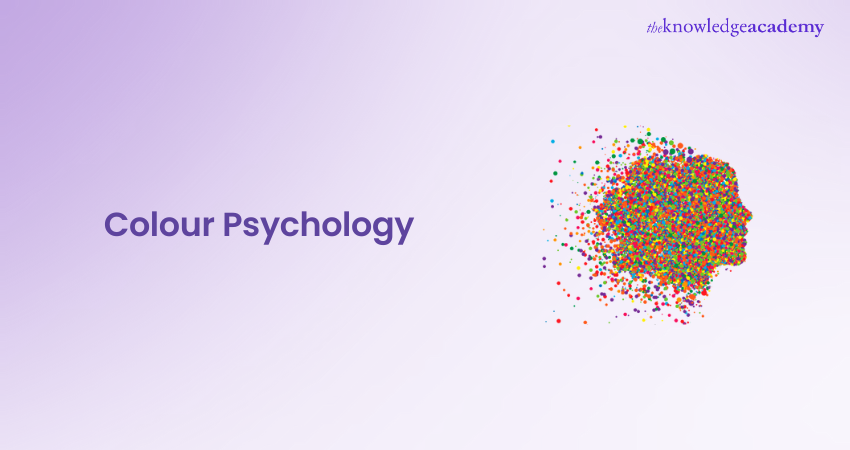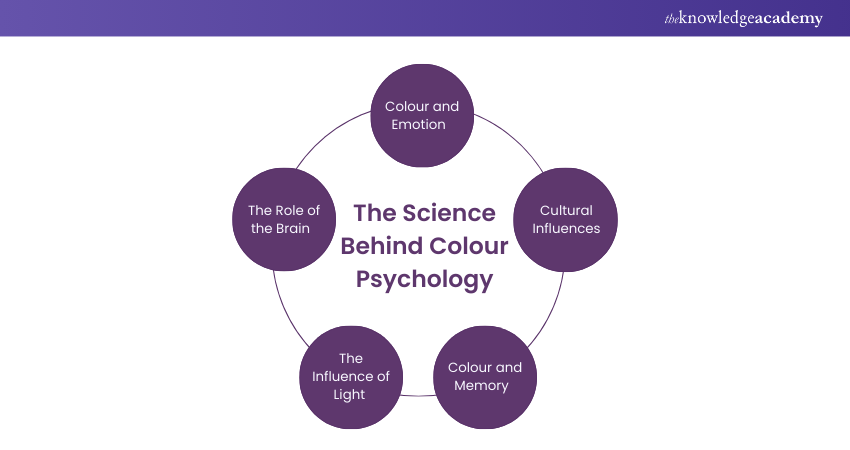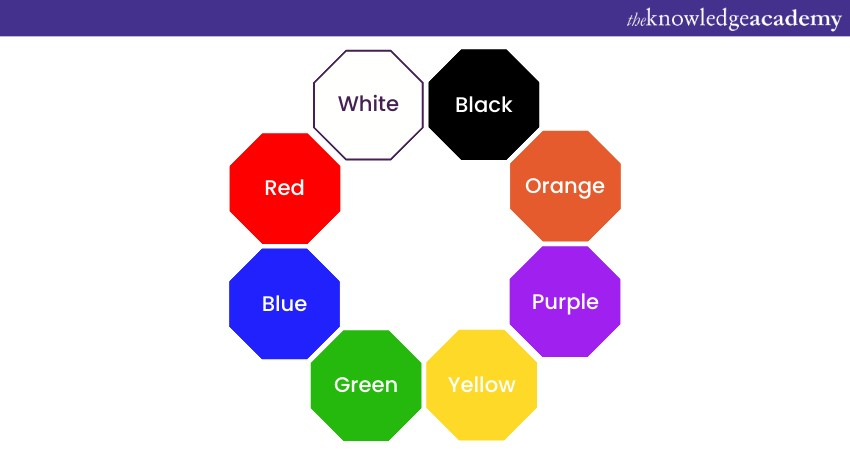We may not have the course you’re looking for. If you enquire or give us a call on +44 1344 203 999 and speak to our training experts, we may still be able to help with your training requirements.
Training Outcomes Within Your Budget!
We ensure quality, budget-alignment, and timely delivery by our expert instructors.

Think about walking into a room painted in soothing blues versus one in vibrant reds – how do you think each would affect your mood? This intriguing phenomenon is at the heart of Colour Psychology. By exploring how different hues influence your emotions and behaviours, you can receive a deeper understanding of the powerful effects colours have on our daily lives.
Colour Psychology delves into these questions, revealing the subtle yet significant ways colours shape our feelings and actions. Ready to discover how the colours around you can transform your emotional landscape? Let’s dive in and comprehend its impact on your feelings.
Table of Contents
1) What is Colour Psychology?
2) The Science Behind Colour Psychology
3) Psychological Effects of Different Colours
4) Colour Psychology on Marketing and Advertising
5) Therapy and Healing With Colour Psychology
6) Learning and Productivity With Colour Psychology
7) Conclusion
What is Colour Psychology?
Colour is not merely a visual experience; it profoundly impacts our emotions, thoughts, and behaviours. Imagine a world without the vibrant red of a ripe apple, the calming blue of a clear sky, or the soothing green of a forest. Such a world would lack the intricate palette of emotions and meanings that colours add to our lives. This interplay between colour and human psychology forms the foundation of “Colour Psychology.”
Colour Psychology explores how our brains perceive and respond to different wavelengths of light, influencing our psychological and physiological well-being. Beyond aesthetics, it plays an important role in art, design, marketing, therapy, and learning environments. Colours are purposefully chosen to evoke specific emotions, influence consumer behaviour, and promote healing and well-being.
The Science Behind Colour Psychology
Colour perception is a complex interplay of biology, psychology, and physics. Our understanding of Colour Psychology is rooted in the intricate workings of the human brain and its interaction with light.

1) The Role of the Brain
Your eyes detect light and send it as electrical signals to the brain through the optic nerve. It then decodes these signals, allowing you to perceive and identify different colours. The primary visual cortex, found in the occipital lobe, processes the raw data from the eyes. However, colour perception goes beyond basic sensory input.
The brain's emotional and cognitive centres, including the amygdala and prefrontal cortex, play a vital role in processing colour-related stimuli. This integration between sensory and emotional processing is what gives colours their psychological significance. For instance, a red stop sign triggers an immediate sense of danger due to the brain's association of red with urgency.
2) Colour and Emotion
The connection between colour and emotion is deeply ingrained in our evolutionary history. Specific colours have been associated with survival instincts. For example, our ancestors learned to associate bright, vibrant colours with ripe fruits and lush vegetation, indicating safety and sustenance. On the other hand, dull or unusually coloured objects could signal danger or spoilage.
This emotional link between colour and survival mechanisms has persisted, influencing our emotional responses to this day. Warm colours, including red and orange often evoke warmth, energy, and caution. Cool colours, including blue and green are associated with calmness, serenity, and stability. Understanding these emotional triggers is essential in various contexts, from designing calming environments to creating attention-grabbing advertisements.
3) Cultural Influences
While there are universal emotional responses to colours, cultural factors significantly shape our colour preferences and interpretations. Different cultures assign varying meanings to colours based on historical, religious, and societal contexts. For example, white is often associated with purity and weddings in Western cultures, but it signifies mourning in some Eastern cultures.
These cultural variations can lead to misunderstandings or misinterpretations, particularly in a globalised world where diverse cultures interact. Businesses and marketers must be sensitive to these cultural nuances when using colours to convey messages or promote products.
Uncover the secrets of the mind and gain insights that can change lives – sign up for our Psychology Course today!
4) Colour and Memory
Colours also have a remarkable ability to enhance memory and aid learning. Research suggests that information presented in colour is more likely to be remembered than in black and white. This phenomenon, known as the "von Restorff effect," highlights the impact of novelty on memory retention. When a specific element, such as text, is presented in a different colour from its surroundings, it stands out and is more likely to be remembered.
Educators and instructional designers have capitalised on this effect using colour-coded materials to aid learning and information retention. Similarly, businesses use colours strategically to make their branding and advertisements more memorable and recognisable.
5) The Influence of Light
Light plays a crucial role in how you perceive colour. Different lighting conditions can alter our perception of colours, sometimes dramatically. The colour temperature of light sources, such as natural sunlight or artificial lighting, can shift how colours appear. This phenomenon has implications for industries such as interior design, where selecting appropriate lighting is crucial to maintaining the intended mood and ambience.
In recent years, digital devices and screens have introduced new challenges. The varying colour profiles of screens and devices can affect how you perceive colours, leading to discrepancies between what is seen on a screen and what is printed on paper.
Psychological Effects of Different Colours
Colours hold a remarkable power to evoke emotions, influence behaviour, and shape perceptions. The psychological effects of different colours are deeply ingrained in our subconscious and have been extensively studied in Colour Psychology.

1) Red
Red is a colour that commands attention. It is associated with strong emotions like passion, love, and anger. This bold hue has been shown to increase heart rate and stimulate the senses, making it a popular choice in contexts where urgency and excitement are desired. It is often used in marketing to encourage impulse buying or draw attention to sales. However, red can also evoke feelings of caution and danger, as seen in stop signs and fire alarms.
2) Blue
Blue is frequently associated with calmness, serenity, and stability. It is known to have a soothing effect on the mind and body, making it a popular choice in environments where relaxation is essential. Blue is mostly used in healthcare settings to create a sense of tranquillity. Moreover, blue is linked to trust and dependability, so many corporate logos and financial institutions utilise this colour to build credibility.
3) Green
Green is closely tied to nature and portrays growth, renewal, and balance. It has a calming effect and is believed to alleviate stress and promote feelings of relaxation. Green environments are associated with increased focus and improved cognitive function. Brands prioritising sustainability and environmental consciousness frequently use green messaging to convey a sense of responsibility.
4) Yellow
Yellow radiates positivity and optimism. It mostly stimulates mental activity and evoke feelings of happiness. In marketing, yellow is often used to create a sense of urgency or to grab attention. However, excessive use of yellow can lead to feelings of anxiety or frustration, as it is a high-energy colour. It is crucial to strike a balance between the cheerful aspects of yellow and its potential overstimulation.
5) Purple
Purple has long been associated with royalty and creativity. It has a sense of mystery and spirituality, often linked to introspection and self-discovery. Lighter shades of purple can evoke romance and nostalgia. Purple conveys elegance and sophistication in design, making it a common choice in the beauty and fashion industries.
6) Orange
Orange has the energy of red with the cheerfulness of yellow. Its colour exudes warmth and enthusiasm, making it a good choice for brands that want to convey friendliness and approachability. Orange is also associated with creativity and stimulation, making it suitable for environments where brainstorming and innovation are encouraged.
7) Black
Black is often linked to sophistication, elegance, and formality. It exudes authority and professionalism, so it is commonly used in luxury branding and high-end products. However, black can further evoke feelings of mystery and sadness. Using black strategically to create a desired atmosphere without overwhelming or stifling is essential.
8) White
White symbolises purity, cleanliness, and simplicity. It is often used to create a sense of openness and space, making it popular in minimalist design. In healthcare settings, white is associated with sterility and hygiene. However, an excessive use of white can lead to a sense of coldness or emptiness, so designers often balance it with other colours.
Understand the beneficial effects of having positive emotions upon daily living with our Positive Psychology Course - join us now!
Colour Psychology Marketing and Advertising
By understanding how different colours evoke specific emotions and reactions, brands can craft more effective marketing strategies. Here are some key aspects to consider:
1) Colours are among the first elements consumers notice, evoking immediate emotional responses. This makes colour selection integral to logo design, packaging, and overall visual identity, helping convey the brand’s personality, values, and market positioning.
2) Marketing campaigns often span cultural boundaries, making it crucial to understand cultural variations in colour meanings. For example, red signifies luck in Chinese culture but can symbolise danger in Western cultures. Brands must tailor their colour choices to resonate positively in different cultural contexts.
3) Consistency in branding is necessary to creating recognition and loyalty. A consistent colour palette helps consumers associate specific colours with a brand, making it instantly recognisable, like McDonald’s red and yellow scheme.
4) Colours are strategically used to guide consumer actions. Calls-to-action (CTAs) in ads and websites often use contrasting colours to draw attention and encourage clicks or conversions, such as “Buy Now” buttons.
5) Distinct colour choices can set a brand apart in competitive markets. Iconic colours like Coca-Cola’s red or Tiffany & Co.'s blue make these brands instantly recognisable.
6) Colours can be leveraged for seasonal campaigns and cultural events. Brands often adopt colours like red and green for Christmas or modify schemes for cultural celebrations to resonate with their audience.
7) In the digital age, Colour Psychology extends to both online and offline spaces. Brands must ensure consistent colours across websites, social media, physical stores, and packaging to reinforce brand identity and provide a seamless customer experience.
Join our Mindfulness Training and learn techniques to reduce stress and enhance well-being - start your journey to a calmer and more focused you today!
Therapy and Healing With Colour Psychology
The idea of using colours for healing dates back to ancient civilisations like the Egyptians, Greeks, and Chinese, each with its own understanding of how colours could influence physical health and emotional states. In ancient Egypt, temples were built with specific-coloured windows to let in light believed to have therapeutic effects. In many Eastern philosophies, the body is believed to have energy centres, or chakras, corresponding to different colours, influencing various aspects of well-being. For example, the heart chakra is associated with green and linked to love, compassion, and balance.
Proponents of colour therapy suggest that exposure to specific colours can affect the body’s energy levels, influencing mood and health. Warm colours like red and orange are thought to increase energy and circulation, while cool colours including blue and green are considered calming and soothing. Colour therapy is often used to address mood-related issues like anxiety and depression, with therapists using coloured objects, fabrics, or light to create a therapeutic environment. Modern medical facilities and wellness centres also incorporate colour as part of a holistic approach to healing, using carefully chosen palettes to promote relaxation and well-being.
Learning and Productivity With Colour Psychology
By comprehending the psychological effects of colours, you can create environments that enhance learning and productivity. Here are some insights into how Colour Psychology can be applied to boost learning and productivity:
a) Stimulating Creativity and Engagement: Colours stimulate creativity and engagement in learning environments. Vibrant colours enhance attention and motivation, with warm colours like orange and red sparking enthusiasm and creativity.
b) Organising Information: Colour coding helps organise information, aiding retention and understanding. It allows individuals to quickly identify relationships between ideas, improving comprehension and memory recall.
c) Improving Focus and Concentration: Specific colours, such as blue, improve focus and concentration by having a calming effect. Incorporating blue into study spaces can create a conducive environment for concentration.
d) Impacting Mood and Emotional Well-being: Colours impact mood and emotional well-being, influencing cognitive performance. Positive colours like green and yellow create a motivating and engaging learning atmosphere.
e) Catering to Diverse Learning Styles: Colour caters to diverse learning styles, especially visual learners. Colourful visuals simplify complex concepts, making them more accessible, while auditory learners benefit from colour-coded organisation and memory reinforcement.
Conclusion
Colour Psychology is a captivating field that reveals the profound impact colours have on our emotions, behaviours, and overall well-being. From enhancing marketing strategies to shaping our daily experiences, understanding how colours influence our psychological state can lead to more intentional and effective choices.
Enhance your cognitive abilities by signing for our Mental Capacity Training – book your spot now!
Frequently Asked Questions

Red is considered the most powerful colour in psychology. It evokes strong emotions, stimulates energy, and can increase heart rate, making it a dominant colour in both positive and negative contexts.

Yellow is known to release dopamine, the feel-good hormone. It is associated with happiness, positivity, and energy, often used to boost mood and motivation.

The Knowledge Academy takes global learning to new heights, offering over 30,000 online courses across 490+ locations in 220 countries. This expansive reach ensures accessibility and convenience for learners worldwide.
Alongside our diverse Online Course Catalogue, encompassing 17 major categories, we go the extra mile by providing a plethora of free educational Online Resources like News updates, Blogs, videos, webinars, and interview questions. Tailoring learning experiences further, professionals can maximise value with customisable Course Bundles of TKA.

The Knowledge Academy’s Knowledge Pass, a prepaid voucher, adds another layer of flexibility, allowing course bookings over a 12-month period. Join us on a journey where education knows no bounds.

The Knowledge Academy offers various Health & Safety Courses, including the Mental Health and Wellbeing Training, Mental Capacity Training, and Mindfulness Training. These courses cater to different skill levels, providing comprehensive insights into Evolutionary Psychology.
Our Health & Safety Blogs cover a range of topics related to Human Psychology, offering valuable resources, best practices, and industry insights. Whether you are a beginner or looking to advance your Health and Safety knowledge, The Knowledge Academy's diverse courses and informative blogs have got you covered.
Upcoming Health & Safety Resources Batches & Dates
Date
 Psychology Course
Psychology Course
Fri 14th Feb 2025
Fri 11th Apr 2025
Fri 13th Jun 2025
Fri 15th Aug 2025
Fri 10th Oct 2025
Fri 12th Dec 2025







 Top Rated Course
Top Rated Course



 If you wish to make any changes to your course, please
If you wish to make any changes to your course, please


